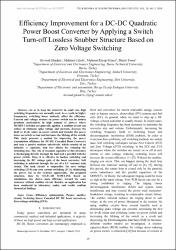Efficiency improvement for a DC-DC quadratic power boost converter by applying a switch turn-off lossless snubber structure based on zero voltage switching
Künye
Ghaderi, D., Celebi, M., Minaz, M. R., & Toren, M. (2018). Efficiency Improvement for a DC-DC Quadratic Power Boost Converter by Applying a Switch Turn-off Lossless Snubber Structure Based on Zero Voltage Switching. Elektronika Ir Elektrotechnika, 24(3), 15-22. https://doi.org/10.5755/j01.eie.24.3.20977Özet
So as to keep the converter in small size, high switching frequencies are normally used. As a result, in higher frequencies, switching losses seriously affect the efficiency. Current and voltage stresses on power switch can be serious problems particularly in high amount of powers where MOSFET switches are generally applied. A snubber circuit can reduce or eliminate spike voltage and currents, decrease the di/dt or dv/dt values on power switch and transfer the power losses on switch to load and increases the lifelong of the switch. This study presents a method for improving the power transmission efficiency for DC-DC Cascaded Boost Converter and uses a passive snubber sub-circuit, which consists of an inductor, a capacitor, and two diodes for reducing the switching loss. the role of resonant capacitor of this structure is discharging directly through the load and is parallel with the power switch. Thus, it is effective in lossless switching and increasing the DC voltage gain of the boost converter. Soft switching is achieved through the use of a LC resonant tank circuit. the tank circuit is responsible for zero voltage switching (ZVS) and zero current switching (ZCS), eliminating the power loss in the switches appreciably. the proposed structure, done by MATLAB SIMULINK based on simulations, has shown more efficiency toward the same structure without snubber circuit. Besides, an application has been conducted in laboratory scales, and results confirm theoretical findings.


















